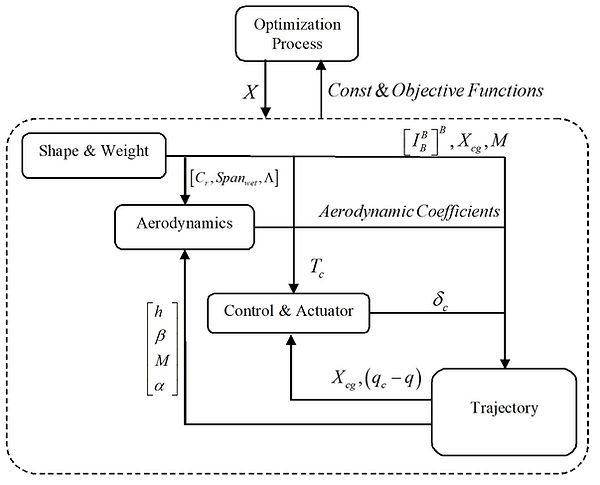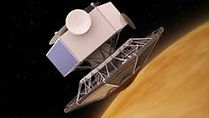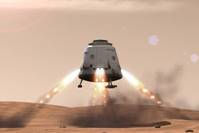Atmospheric Flight Mechanics (High-Speed Launch and EDL Problems)
This research considers motion and control of various types of vehicles within the atmosphere of the Earth or Mars. Trajectory of these vehicles consists of several phases. For instance, the trajectory of a typical launch vehicle consists of several phases one of which occurs within the denser region of the Earth's atmosphere (that is the endo-atmospheric phase). Another example corresponds to the Entry, Descent, and Landing (EDL) phases of Mars missions that are designed to land a rover or some payload on the surface of Mars. In order to achieve the best desired performance, it is important to apply optimal control theory to optimize the trajectory and have high landing accuracy. Several interesting optimal control problems arise in the domain of atmospheric flight including powered ascent, aerocapture, and EDL and we are developing algorithms to solve the ensuing optimal control problems with enhanced optimization algorithms.
Goddard Rocket Problem (Sounding Rockets)
A prominent atmospheric flight problem corresponds to the maximum vertical altitude that can be achieved by a sounding rocket, which is known as the Goddard rocket problem. The objective is to maximize the altitude of a rocket that is subject to gravitational pull and the atmosphere of Earth during a near vertical flight. For several decades the solution to this problem was believed to be simple: just fire the rocket such that the force produced by its engine takes its maximum value until its propellant is entirely consumed. However, in order to achieve the maximum altitude and using optimal control principles (and depending on the formulation of the problem), the optimal thrust program turns out to consist of three main segments: 1) an initial segment designated by a maximum thrust (lower right subplot in figure below), 2) an intermediate segment during which the thrust profile exhibits a peculiar behavior until the propellant is fully consumed; the thrust value takes intermediate values, and 3) a pure coast (zero-thrust) segment until the rocket reaches its maximum altitude. The Goddard rocket problem is one of the representative problems that signifies the utility of optimal control theory. In practice, however, there are other considerations that may have higher priority over pure optimality measures. But, mission designers are interested to have an accurate estimate in the level of optimality that has been sacrificed to satisfy other mission constraints. The tools developed at the ACE lab. are capable of solving these types of challenging problems.

Multidisciplinary Design Optimization: Launch Vehicle Trajectory Design & Shape-Optimization
Multidisciplinary Design Optimization (MDO) is a branch of optimization that presents a distinct view when vehicle design is of interest. There are many disciplines of aerospace engineering that should collaborate to achieve the best vehicle performance. In a traditional approach to vehicle/system design, each discipline seeks to maximize certain parameters that measure performance. For instance, in aircraft design, the aerodynamics discipline seeks to design the most efficient aerodynamic configuration, whereas the structure discipline seeks to minimize the mass while considering acceptable safety margins. Similarly, the goal of the propulsion disciple is to size the best engine. Obviously, these disciplines have to collaborate with each other in order to converge to the best design. While not a very new concept, MDO presents a paradigm shift in design. It deviates from a discipline-centric design philosophy an offers a collaborative-based design approach that takes the interconnection of disciplines. The final design may not necessarily be ideal from the point of view of individual disciplines (i.e., not optimal from a local-discipline view), but the best performance is achieved.
Below is an example for an MDO approach to a two-stage launch vehicle design in which the size of the aerodynamic surfaces and vernier thrusters are optimized in order to achieve maximum payload that can be put into a parking orbit. For each set of parameters (stabilizer aerodynamic parameters and thrust value of four vernier thrusters), the weight and aerodynamic performance of the vehicles changes. The thrust of the vernier thrusters changes the mass and the aerodynamic parameters also change the mass of the vehicle. In addition, the aerodynamic performance of the vehicle changes. Therefore, it is important to update static and stability aerodynamic coefficients, which will be used for calculating aerodynamic forces and moments along a to-be-determined trajectory. A 6DoF flight simulation has been developed that has several components. One of the components performs 4-dimensional interpolations (over the altitude, Mach number, side-slip angle and angle of attack). A flight controller is also developed to track the optimal trajectory and determines the maximum deflection angles of the vernier thrusters that are responsible for attitude control of the vehicle. An (evolutionary) optimizer iterates over the feasible set of design variables and the objective value is returned. Eventually, the optimizer converges to the best configuration and set of parameters with respect to the defined constraints and objective function.





Aerocapture
One of the phases of space mission is to capture a probe around a planet to prepare it for its science phase. Often times, a number of engine thrust burns are scheduled in order to reduce the energy of the spacecraft with respect to the planet since spacecraft approaches the planet on a hyperbolic trajectory. One idea proposed is to use atmospheric forces to dissipate energy. The entry vehicle is said to be aerocaptured into an orbit when the vehicle dives just once into the lower part of the atmosphere to dissipate significant amount of kinetic energy. One of the most important constraints that has to be taken into account is the heat-rate constraint since the vehicle enters the atmosphere at a very high speed. The heat-rate constraint is proportional to the third power of the relative velocity of the entry vehicle. A schematic of a Martian aerocapture maneuver is shown below. For real-world problems, technological constraints, often time, take precedence over prescribed optimality (with respect to the defined criteria). Mission designers and decision makers are interested in solutions that do not violate constraints while allowing the most scientific outcome. In the ACE lab., we have developed tools and are still doing research on methods to deal with these types of constrained optimal control problems.

Entry, Descent, and Landing on Mars
One of the most challenging aspects for any space mission to Mars is to perform a soft landing on the Martian surface. The mission phase of the entry vehicle once it enters the Martian atmosphere is dubbed as the entry, descent, and landing (EDL) phase. The atmosphere of Mars poses challenges of two types: 1) the atmosphere is thick enough to cause heating issues for the entry vehicle and burn it down to ashes, but 2) the atmosphere is not thick enough to provide required deceleration, thereby causing the entry vehicle to impact at supersonic speeds on the Martian surface. Only 7 successful soft landings on Mars have been performed in the human history (all of them by NASA). Using the current technologies, only 2 metric tonnes (or two times the Curiosity Rover) can be landed on Mars. However, human-class missions require around 20 metric tonnes to be landed, which requires thinking of new solutions altogether.


NASA Ames Research Center devised and developed Adaptable Deployable Entry Placement Technology (ADEPT). This technology has been dubbed as the "Mary Poppins Approach" to land human-class payloads on Mars. The structural mass of ADEPT makes it less attractive than HIADs.
NASA Ames Research Center devised and developed Adaptable Deployable Entry Placement Technology (ADEPT). This technology has been dubbed as the "Mary Poppins Approach" to land human-class payloads on Mars. The structural mass of ADEPT makes it less attractive than HIADs.


SpaceX has been a long time proponent of using Supersonic Retro-Propulsion (SRP) for EDL on Mars. In order to decelerate, the retro rockets light up in the direction opposite to the motion of the entry vehicle. Thus, the vehicle slows down and performs a safe landing at the cost of expensive rocket fuel.
The fourth option that has been studied at ACE lab and adopted by SpaceX recently is the use of lifting bodies. The idea is to fly the entry vehicle for 99% of its EDL phase using the freely available Martian atmosphere using the high lifting abilities of the entry vehicle. The high lift force enables the drag force to be applied for a considerable time upon the entry vehicle, thereby slowing it down to subsonic speeds. The remainder 1% of the trajectory could employ subsonic retro-propulsion or other conventional landing techniques on Mars.

Relevant Publications
-
Kshitij Mall, Michael. J. Grant, and Ehsan Taheri, "Trigonometrization of Optimal Control Problems with Control Constraints Involving Non-Linear Controls," IEEE Transactions on Control Systems Technology [under review].
-
Ehsan Taheri and John L. Junkins, "Hyperbolic-Tangent-Based Double-Smoothing Method And Its Application In Optimal Control," (AAS-18-379), AAS/AIAA Astrodynamics Specialist Conference, August 19 - 23, 2018, Snowbird, Utah, USA. https://www.xcdsystem.com/aas/program/OjvenM6/index.cfm?pgid=1491
-
Roshanian, Jafar, Ehsan Taheri, et al. "Multidisciplinary design optimization of space transportation control system using genetic algorithm." Proceedings of the Institution of Mechanical Engineers, Part G: Journal of Aerospace Engineering 228.4 (2014): 518-529. https://journals.sagepub.com/doi/full/10.1177/0954410013475573
